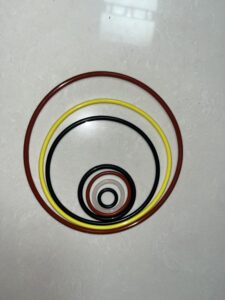Table of Contents
ToggleHow to Measure an O-Ring: A Comprehensive Guide
Accurately measuring an O-ring is essential for achieving reliable seals in automotive, industrial, HVAC, and plumbing systems. This guide provides a detailed, step-by-step process to determine the three critical dimensions of an O-ring: Inner Diameter (ID), Outer Diameter (OD), and Cross-Sectional Thickness (CS). Whether you’re replacing a worn seal or sourcing parts for a custom application, precise measurements ensure compatibility and performance.

Tools Required for Measurement
Before starting, gather the following tools to ensure accuracy:
- Digital or Manual Caliper: Ideal for measuring ID, OD, and CS with precision (recommended for professional use).
- Ruler or Tape Measure: Suitable for approximate sizing if a caliper is unavailable.
- Non-Stretch String or Flexible Tape: Useful for measuring the inner circumference as an alternative method.
- Flat Surface: Ensures the O-ring remains stable during measurement.
Step-by-Step Measurement Process
1. Measuring Cross-Sectional Thickness (CS)
The cross-sectional thickness refers to the diameter of the O-ring’s material itself. Follow these steps:
- Place the O-ring on a flat, non-slip surface.
- Gently compress the O-ring to ensure it lies flat without stretching.
- Use the caliper to measure the thickness from one edge of the material to the opposite edge, perpendicular to the ring’s loop.
- Record the measurement in millimeters (mm) or inches (in).
Example: If the caliper reads 3 mm, the CS is 3 mm.
Pro Tip: Take measurements at multiple points to account for wear or deformation, especially in used O-rings.
2. Determining the Inner Diameter (ID)
The inner diameter is the distance across the O-ring’s central hole. Two methods can be used:
Method A: Using a Caliper
- Flatten the O-ring slightly into an oval shape without stretching it.
- Measure the distance between the inner edges at the widest point.
- Repeat this process at 2–3 locations and calculate the average for accuracy.
Method B: String or Tape Measure
- Wrap a non-stretch string or flexible tape around the inner circumference of the O-ring.
- Mark the length where the string overlaps.
- Divide the circumference by π (3.14) to approximate the ID:
ID = Circumference ÷ π
Note: Caliper measurements are more accurate. Use Method B only as a backup.
3. Calculating the Outer Diameter (OD)
The outer diameter can be derived mathematically once the ID and CS are known:
OD = ID + (2 × CS)
Example:
- ID = 30 mm
- CS = 3 mm
- OD = 30 mm + (2 × 3 mm) = 36 mm
Verification: If possible, measure the OD directly with a caliper to confirm calculations.


4. Cross-Referencing Standard Sizes
O-rings are standardized globally. Compare your measurements to these systems:
- AS568 (U.S. Standard): Common in automotive applications (e.g., AS568-020).
- ISO 3601 (International Standard): Widely used in industrial and hydraulic systems.
- JIS B 2401 (Japanese Standard): Prevalent in Asian markets.
Example: An O-ring with a 30 mm ID and 3 mm CS might correspond to AS568-220 or ISO 3601-3.00×36.
Key Considerations for O-Ring Selection
Material Compatibility
O-ring materials (e.g., nitrile, Viton, silicone) must withstand the application’s temperature, pressure, and chemical exposure. For example:
- Nitrile (Buna-N): Resistant to oils and fuels (ideal for engines).
- Viton (FKM): Suitable for high-temperature and chemical-heavy environments.
Color Coding Myths
While debates exist about black vs. green O-rings (e.g., black for general use, green for refrigerant systems), prioritize material specifications over color.
Pre-Packaged Kits
For automotive repairs, use vehicle-specific kits (e.g., 2011–2013 Ram 3500 A/C Seal Kit) to avoid measurement errors. Universal kits like the Santech 270x Rapid Seal Repair Kit include 18 sizes, ideal for older or non-standard applications.
Practical Applications & Troubleshooting
Case Study: A/C System Repair
A damaged O-ring in a 2012 Ram 3500’s A/C system caused refrigerant leaks. By measuring the original O-ring (ID: 12 mm, CS: 2 mm), the technician matched it to the AS568-012 standard and used the Santech kit for a leak-free replacement.
Handling Deformed or Worn O-Rings
- Measure multiple points and calculate averages.
- Prioritize replacements from trusted brands like Jinan Retek for critical applications (e.g., 90-degree aluminum fittings).
When to Seek Professional Guidance
For complex scenarios—such as custom hydraulic systems or bulk orders—consult manufacturer specifications or retailers like https://fyoilseal.com/and Amazon. Provide your ID, OD, and CS measurements to ensure accurate part matching.
Final Checklist
- Measure CS with a caliper.
- Determine ID using Method A or B.
- Calculate OD (or measure directly).
- Cross-reference standards.
- Verify material compatibility.
By following this guide, you can confidently measure O-rings, select the correct replacements, and maintain optimal performance in any mechanical system.



Leave A Comment